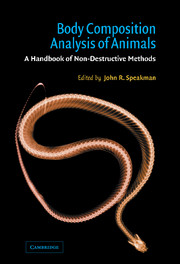Book contents
- Frontmatter
- Contents
- List of contributors
- Preface
- Acknowledgements
- Introduction
- 1 Morphological indicators of body condition: useful or wishful thinking?
- 2 Standard methods for destructive body composition analysis
- 3 The isotope dilution method for the evaluation of body composition
- 4 Gas dilution methods: elimination and absorption of lipid-soluble gases
- 5 The use of total body electrical conductivity (TOBEC) to determine body composition in vertebrates
- 6 The use of bioelectrical impedance analysis (BIA) for estimation of body composition
- 7 The assessment of body composition and other parameters by ultrasound scanning
- 8 The use of dual-energy X-ray absorptiometry for the measurement of body composition
- Index
8 - The use of dual-energy X-ray absorptiometry for the measurement of body composition
Published online by Cambridge University Press: 19 January 2010
- Frontmatter
- Contents
- List of contributors
- Preface
- Acknowledgements
- Introduction
- 1 Morphological indicators of body condition: useful or wishful thinking?
- 2 Standard methods for destructive body composition analysis
- 3 The isotope dilution method for the evaluation of body composition
- 4 Gas dilution methods: elimination and absorption of lipid-soluble gases
- 5 The use of total body electrical conductivity (TOBEC) to determine body composition in vertebrates
- 6 The use of bioelectrical impedance analysis (BIA) for estimation of body composition
- 7 The assessment of body composition and other parameters by ultrasound scanning
- 8 The use of dual-energy X-ray absorptiometry for the measurement of body composition
- Index
Summary
Introduction and historical overview
Dual-energy X-ray absorptiometry (DXA) is a rapid, non-invasive technique that allows for the measurement of total and regional bone mineral (TBBM, g), total bone mineral density (TBMD, g/cm2), fat mass (FM, g) and bone-free lean tissue mass (LM, g) in vivo in animals ranging in size from man to mouse. Since its introduction slightly more than a decade ago (Cullum et al., 1989; Mazess et al., 1989; Blake & Fogelman, 1997), DXA has become the most widely used technology for measuring TBBM and TBMD in humans, and its use for determining FM and LM mass is widespread. The use of DXA in animal research is also increasing (Grier et al., 1996). Recent advances in both hardware and software now allow for the determination of body composition in mouse-sized animals (Hunter & Nagy, 1999; Nagy & Wharton, 1999; Nagy et al., 1999a,b; Nagy & Clair, 2000).
Historically, the use of absorptiometry or densitometry for the measurement of TBBM and TBMD began with the advent of single-photon absorptiometry (SPA) in the 1960s (Cameron & Sorenson, 1963; Cameron et al., 1968). Although this technique proved useful, its applicability was limited to measuring bones that could be immersed in water or other soft tissue-like materials (Grier et al., 1996; Blake & Fogelman, 1997). The development of dual-photon absorptiometry (DPA) overcame the limitations of SPA and allowed for the determination of TBBM and TBMD in areas that were not surrounded by homogeneous soft tissue. In addition, the use of a second energy level allowed for the determination of two tissue types simultaneously (Gotfredsen et al., 1986; Heymsfield et al., 1989; Mazess et al., 1990).
- Type
- Chapter
- Information
- Body Composition Analysis of AnimalsA Handbook of Non-Destructive Methods, pp. 211 - 229Publisher: Cambridge University PressPrint publication year: 2001
- 11
- Cited by



